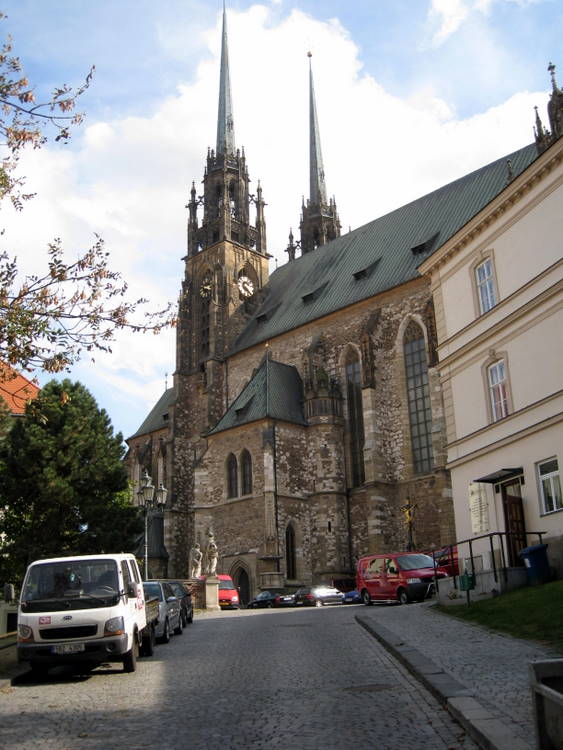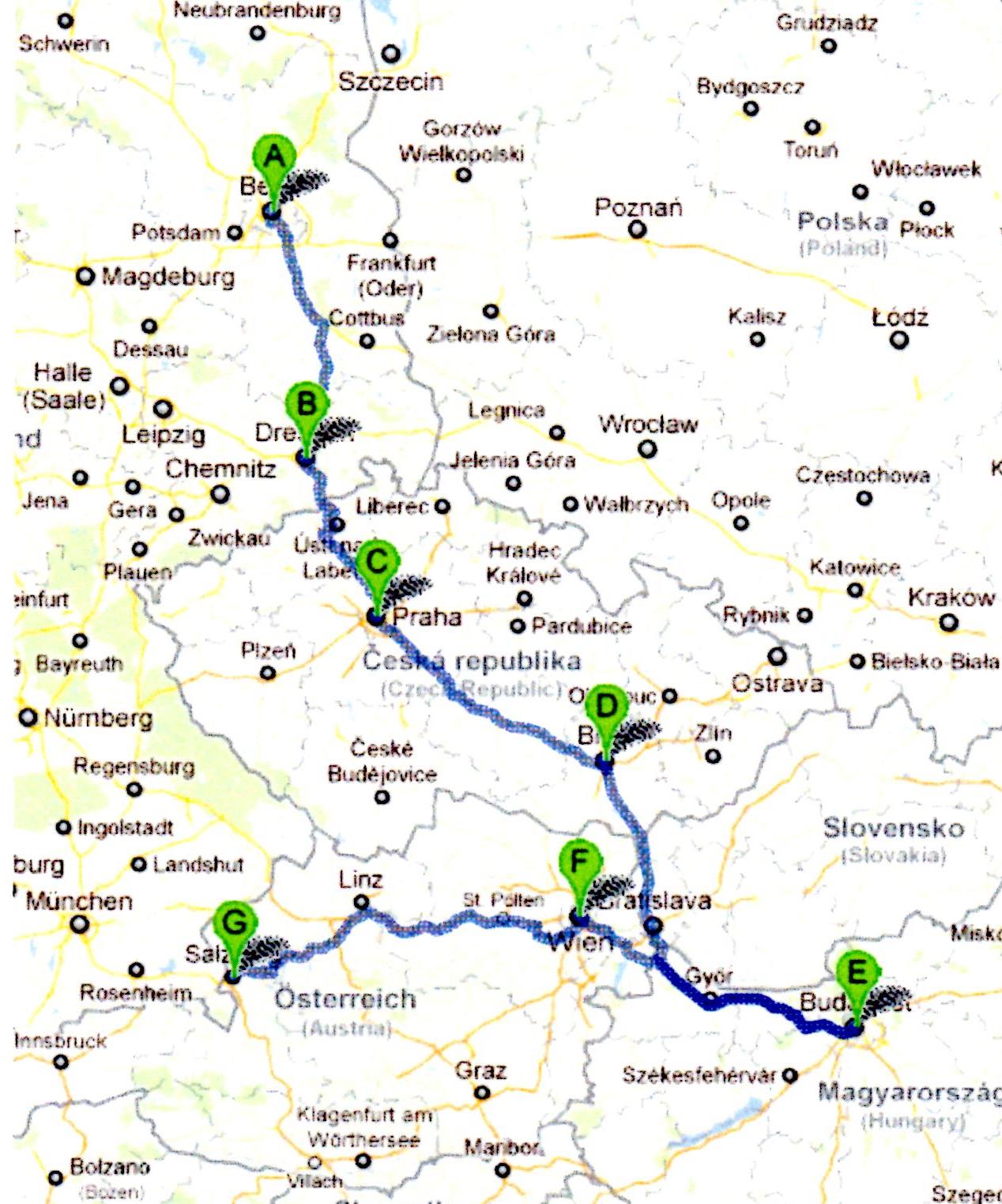CENTRAL EUROPE 2011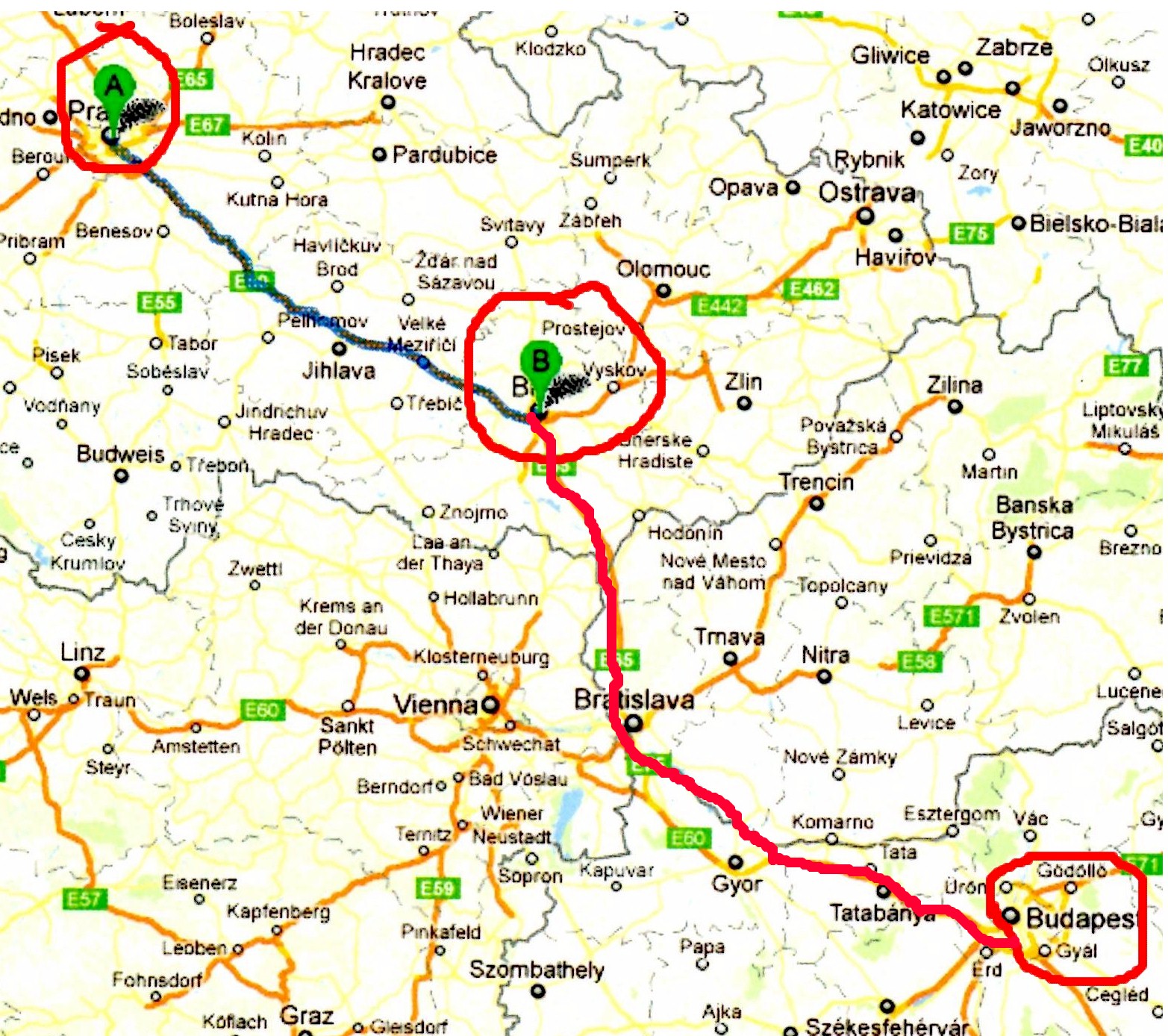
Day 11
September 12 Monday
Brno
We packed up and checked out of our beautiful
apartment.. The hotel limo took us
to the train station. We were a
little early but the train was on time. It
was a three hour ride from Prague (A) to Brno (B). We
had decided when planning this trip that an eight hour train ride to Budapest
was too long. 
We arrived in Brno
about 1:30. Our hotel, Bruno’s
Grand Hotel, was almost across from the train station.
We had a nice suite – a sitting room and a large bedroom.
BRNO
Brrno
is the second largest city in the Czech Republic with a population of over
370,000. It is the capital city of
Moravia and was established over 800 years ago. It prospered quickly due to its
proximity to Prague, Vienna, Bratislava, and Budapest.
One of the focal points is the St. Peter and Paul cathedral on top of the
hill. We started our trek up through
the historic center and found a McDonald’s where we had lunch.
It was a very modern and well appointed dining room. 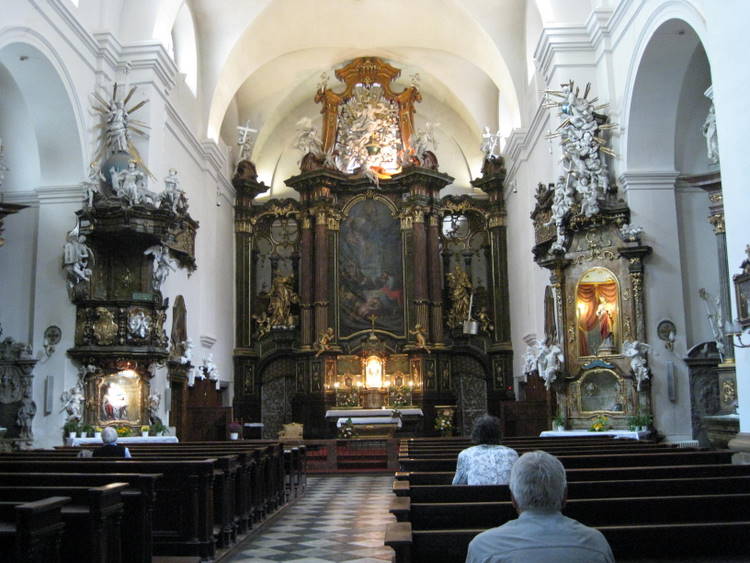
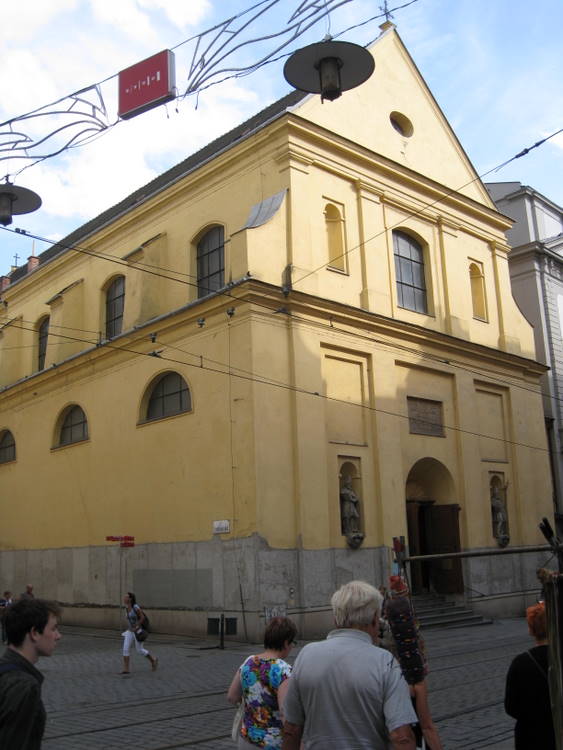 Our next stop was the former Franciscan St.
Mary Magdalene Church. The church
was constructed in 1651-54 and consecrated in 1673. It was restored after a fire
in 1852. It was very Baroque inside
but rather plain yellow structure on the outside.
Our next stop was the former Franciscan St.
Mary Magdalene Church. The church
was constructed in 1651-54 and consecrated in 1673. It was restored after a fire
in 1852. It was very Baroque inside
but rather plain yellow structure on the outside.
We made a left turn in front of the church and came
out in the vegetable market (Zelny trh). It
has been a market for farm ers since the 13th century. Today, it
offers mainly fruit, vegetables and flowers.
It appeared to be very busy.
ers since the 13th century. Today, it
offers mainly fruit, vegetables and flowers.
It appeared to be very busy.
Next we went up a very steep walk towards the
Church of St. Peter and St. Paul.
My wife sent me on ahead to see how far it was
to the church before she started the climb. The
church was on top of the hill and there was no place to get a full photo.
Because of its prominent place on top of the hill,
it can be seen from all over Brno. It was built as a Gothic Cathedral, an
extension of a Romanesque church, around the late 13th century. It was
converted into a Baroque style in the 18th century and reached its
current neo-Gothic style at the turn of the 20th century. 
Inside was very interesting architecture,
combination of gothic, neo gothic and baroque.
At one point we and another lady were the only people in there.
There is an interesting story about why the cathedral’s bells strike
noon at 11 A.M. This can be traced
back to a quick-thinking monk who somehow learned during the Thirty Years’ War
that the Swedes were planning to take the town by noon.
If unsuccessful by then, they would move on.
Not wanting to take any chances against the Swedish army he rang the noon
bells at 11 A.M. prompting the Swedes to pack up and leave and thus saving his
beloved Brno.
We went back down the hill to the vegetable market
and took a street to the left and at the end of that street turned right and
come out on Freedom Square. This is the heart of the city.
It really isn’t a square but more like a triangle.
A
block away was St. James church.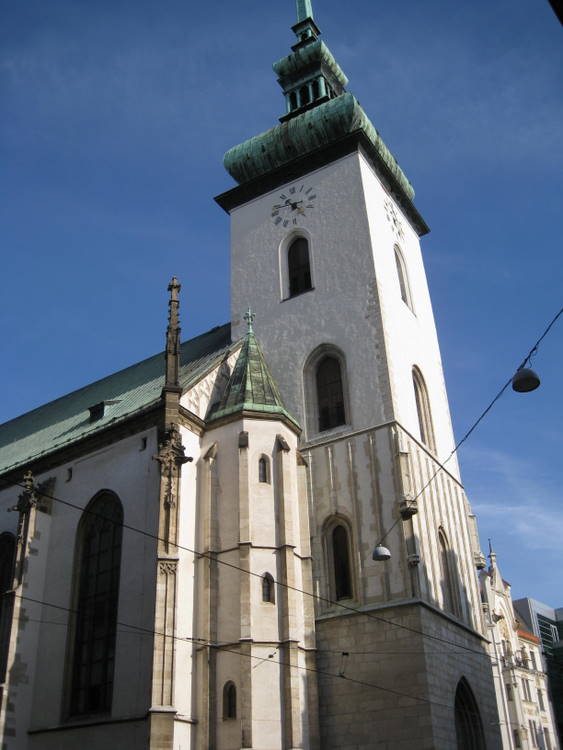
The original church, built between 1201-22 was
replaced by a late Gothic style which
was built in two phases. The first
phase was the chancel which was completed in 1473.
The triple nave was finished in 1502 and roofed by 1530.
In 1878, the church underwent a neo Gothic style revival.
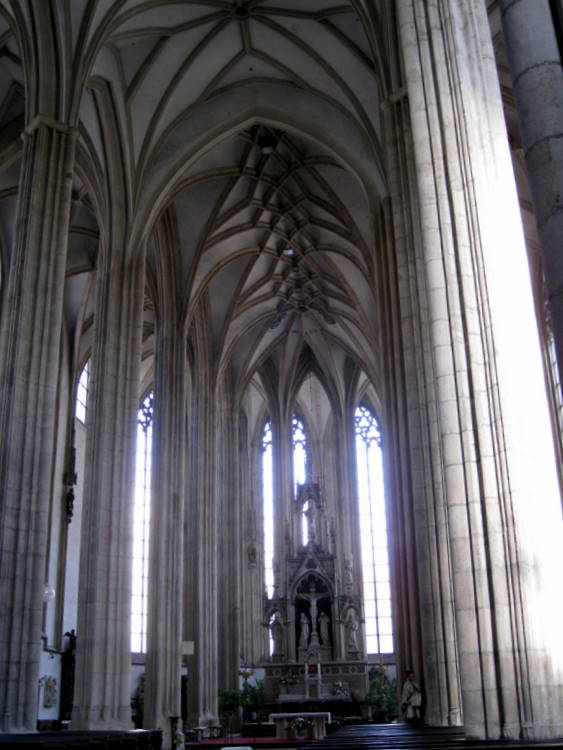
It was light and airy on the inside. The nave
vaulting, although netted just like the vaulting of the chancel is flatter and
simple in its design. The ribs are
not stone but plaster and stucco and have only a decorative function. There
are nine artificial marble altars around the exterior walls. Originally there had
been seventeen of them. The main altar is
carved from several kinds of marble. On
top of the reredos is a statue of St. James. 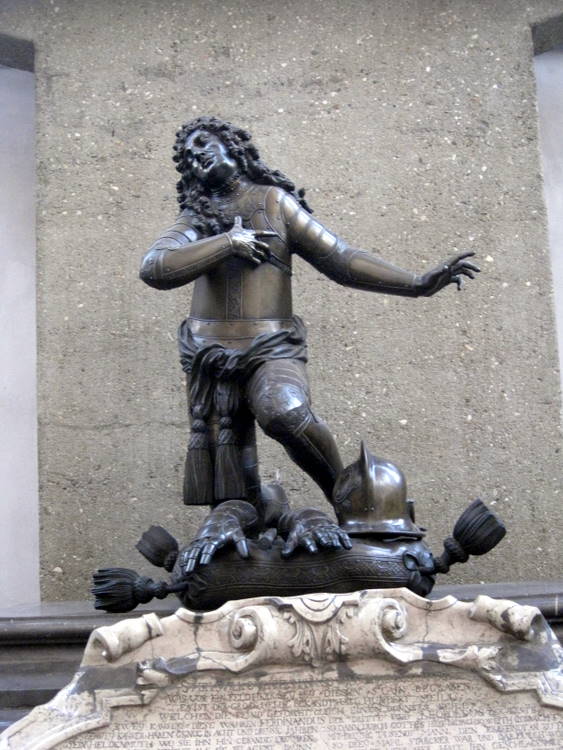
Behind the altar, against the back wall of the apse, is an interesting
statue of Raduit de Souches. He had
distinguished himself as a military commander of the town during the battles
with the Sedes in 1645. His
sepulcher, construced in 1717, is
quite large and consists of a marble tomb which contains a “cartouche” (a
large oval plaque) which lists all of his heroic deeds.
On top of the tomb is a kneeling statue of Souches with his coat of arms,
war tropies and little angels (putti) in the background.

It was impossible to get a full photo of the front
exterior. The east end and the apse
were located on the street behind. We
were able to get several good photos of the back from there.
We started walking back to the hotel, and stopped at a sidewalk café for
a drink. We found our way back
to the hotel. There were many
beautiful building in this area.
We wanted to get our reserved seats for the train
the next day so we walked across the street to the train station to get our seat
reservations. We came back to
the hotel and had another drink in their very attractive bar.
Later we went to the hotel dining room.
It was tastefully decorated, but only one other person in there.
She was across the room and heard us speaking English.
We talked back and forth for a few minutes and then invited her to join
us which she did. She was from
California and worked for a travel agency. We
had a good time talking. I had pork
tenderloin and my wife had duck. It was amazing that no one else came into this
restaurant the rest of the evening.



 Our next stop was the former Franciscan St.
Mary Magdalene Church. The church
was constructed in 1651-54 and consecrated in 1673. It was restored after a fire
in 1852. It was very Baroque inside
but rather plain yellow structure on the outside.
Our next stop was the former Franciscan St.
Mary Magdalene Church. The church
was constructed in 1651-54 and consecrated in 1673. It was restored after a fire
in 1852. It was very Baroque inside
but rather plain yellow structure on the outside. ers since the 13th century. Today, it
offers mainly fruit, vegetables and flowers.
It appeared to be very busy.
ers since the 13th century. Today, it
offers mainly fruit, vegetables and flowers.
It appeared to be very busy.